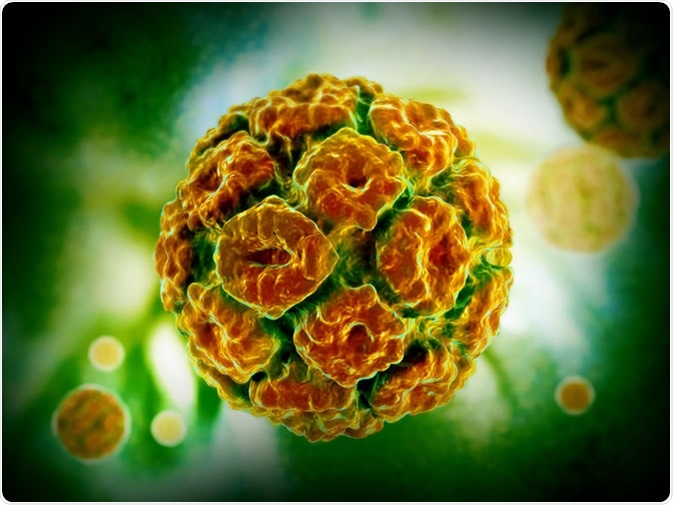Genital warts are a sexually transmitted disease that is caused by the human papillomavirus (HPV). There are various treatment and preventative options available for genital warts.
External genital warts (EGW) are one of the most common sexually transmitted diseases affecting the population, with new cases of EGW each year reaching as high as 1 million in the United States (US). Contracting certain strains of human papillomavirus (HPV) can lead to the development of EGW, with the HPV6 and HPV11 subtypes being commonly associated with EGW.
Genital warts have four main features: condylomata acuminata (CA), smooth papular lesions, flat papular lesions, or keratotic warts. Infection with HPV can be symptomless; asymptomatic persons are more likely to spread the disease because they do not know they are infected. Genital warts can cause other symptoms such as discomfort, vaginal discharge, bleeding, obstruction of the birth canal, and neonatal infection.

Human Papillomavirus 3D Illustration: Liya Graphics / Shutterstock
How prevalent are genital warts?
Over the last few decades, the prevalence of HPV infections has risen dramatically. This increase in prevalence is thought to be associated with an earlier onset of sexual activity and an increased number of sexual partners among the general population. Studies have shown that almost half of these new cases will affect individuals between the ages of 15 and 24 years.
HPV is extremely contagious and is spread mainly through sexual acts that exchange sexual bodily fluids (such as oral, genital, or anal sex).
Risk factors associated with contracting HPV include engaging in unprotected sex, having a history of sexually transmitted infections, immunosuppression, and smoking.
Virology of genital warts
HPV is a double-stranded non-enveloped DNA virus. HPV replication mainly occurs in the basal layer of surface tissues, but the genital tract mucosa is also susceptible to HPV infection.
The genome of HPV contains 8 separate reading frames which contribute to the diversity of virus expression. Six of these reading frames are referred to as early-open genes (E genes) and they are crucial for the regulatory function of HPV. These 6 E genes encode for proteins involved in various processes including viral replication and changes to the cell shape. The other two reading frames are the late-open genes (L genes) which encode for the viral capsid proteins. The differences between the L genes alters DNA replication in HPV which contributes to the different subtypes. The differences in the E genes lead to the expression of different HPV-related diseases such as cervical cancer and EGW.
How are genital warts prevented and treated?
Use of quadvirulent and nonavalent HPV vaccines can reduce the risk of genital warts. HPV4 has been used to prevent cervical, vulvar, and vaginal cancer in young women. Its effectiveness in preventing EGW is 99% in patients who have no evidence of prior HPV exposure. An HPV2 vaccine has also been used to prevent the development of EGW and HPV-associated cancers.
The treatment of genital warts is very expensive, at approximately $220 million in the US in 2004. It can safely be assumed that with the increase of incidence since then, this figure would be even higher.
The main method of treating CA is to remove the warty growths instead of removing the infection. The literature suggests that this treatment option isn't greatly effective for long-term removal of the warty growths, as the persistent infection means more growths can always develop. There are many different treatment options available for EGW, including:
- Podophyllotoxin 0.05% solution
- Imiquimod 3.75% or 5% cream
- Sinecatechins 15% ointment
- Trichloroacetic acid 80–90% solution
- Electrosurgery
- Carbon dioxide laser therapy
However, due to the varied expression of the disease between individuals, there is no ideal standard of care for EGW and each of these treatment options has varied success. Thus, prevention through vaccination is far more effective for avoiding genital warts.
Further Reading
Last Updated: Apr 14, 2019